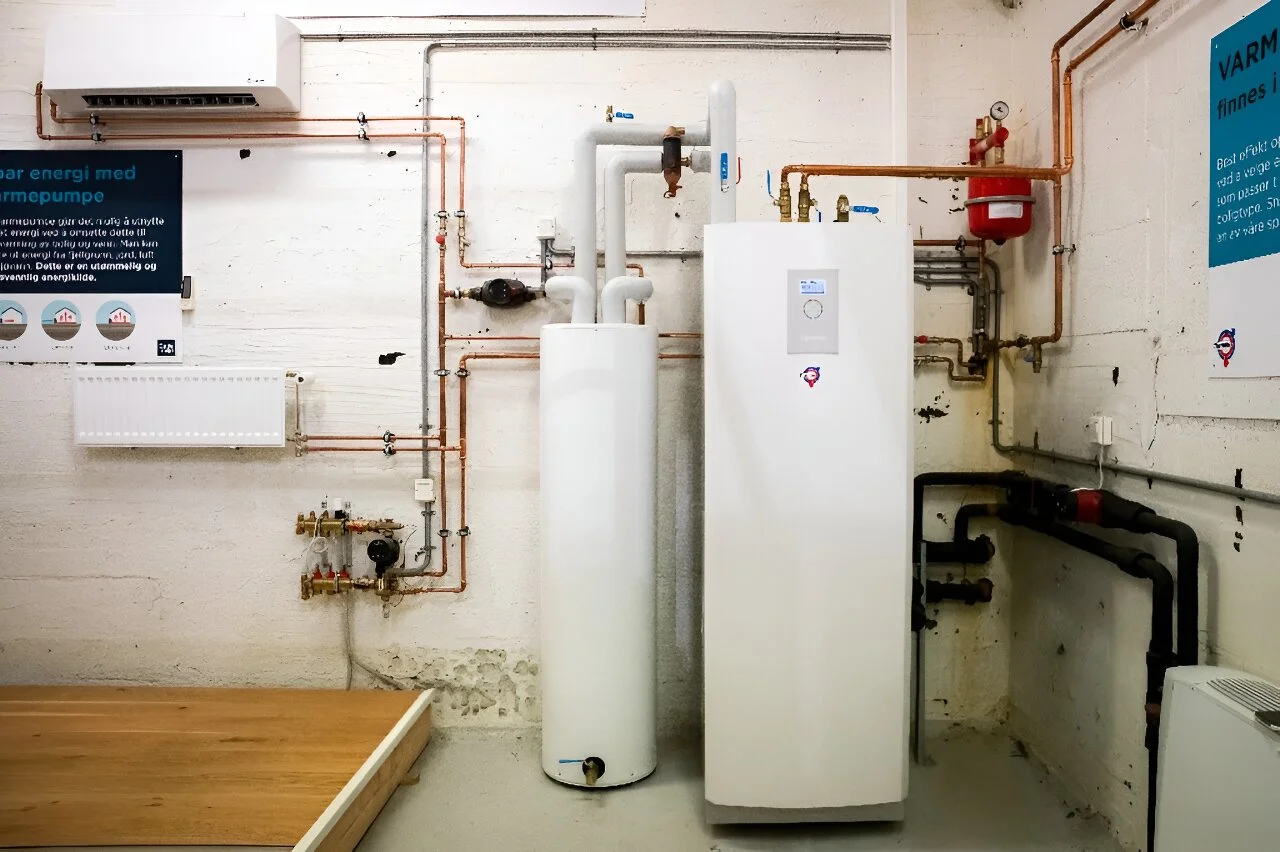- cross-posted to:
- [email protected]
- [email protected]
- [email protected]
- cross-posted to:
- [email protected]
- [email protected]
- [email protected]
Heat pumps can’t take the cold? Nordics debunk the myth::By installing a heat pump in his house in the hills of Oslo, Oyvind Solstad killed three birds with one stone, improving his comfort, finances and climate footprint.
It never ceases to amaze me how people don’t read past the title 🤦 There are people debating about -10 to -30C when the article clearly states that it works in those temperatures. Not only does it work, it’s twice as efficient as electrical heating at those temperatures.
I think it does, and it seems to work because of a defrosting feature that earlier models didn’t have. But I wouldn’t say it does so very clearly. Unless I missed it.
deleted by creator
Electric heat is not always 99.9% efficient, resistive heating is.
Heat pumps are more than 100% efficient(compared to resistive heating)
It’s not bs, because we are moving heat, not creating it. You thinking it is bullshit will not change the laws of thermodynamics. Try to think about it this way.
“Cold” is a made up human concept, it really is a lack of heat energy. The coldest is 0K, but even a Midwest winter is waaaaaay above that. Heat pumps (and all refrigerant-based systems) work by changing the phase of the refrigerant from liquid to gas to cool, or by compressing a gas to a liquid. This phase change takes energy from the surrounding air (think about computer duster, the can gets cold) and then pipes it inside, where it can be compressed to release the heat it just picked up from outside. In the summer you flip the reverse switch to cool your house.
Here is an explanation from someone much more eloquent than myself:https://youtu.be/7J52mDjZzto?si=sYlNlpvGnJs16lwk
Here is an alternative Piped link(s):
https://piped.video/7J52mDjZzto?si=sYlNlpvGnJs16lwk
Piped is a privacy-respecting open-source alternative frontend to YouTube.
I’m open-source; check me out at GitHub.
I just don’t buy this twice as efficient bullshit.
Do you understand how heat pumps work? The heat you’re drawing on is the the heat of the outside compartment on the outside, therefore the heat moved to the inside can be more than just the heat equivalent of the electric energy you put in. That’s how these achieve more than 100% efficiency, in general. In fact if the outside isn’t so cold outside they can achieve 300%-500%.
Now the trick to moving heat from a cold outside compartment to a warmer inside compartment lies in the compression. If you draw even a moderate amount of heat energy into your medium, then compress it, it will turn quite hot allowing you to dump heat into your warm inside compartment. Then as the medium flows out you let it expand and it turns really cold, cold enough that it can draw in heat from the cold outside. But the lower the difference in temperature of the outside air to your expanded medium gets the less heat you can transport per unit of time, that’s why we’re only looking at 200% here.
You also have the waste heat being converted into useful heat, which only helps the efficiency. A standard resistive heater is almost all waste heat, so if you can use some of that energy to get more heat from elsewhere, that’s how you can get 100%+ heat efficiency.
So you’d rather trust your feelings? Just loon into it if you’re that skeptical.
Arrogantly uninformed. It’s an impressive combination
“at those temperatures”
well, to a heat pump even -40° is still 230K, which is plenty of energy to move around and work with. It may be cold to you, but to a heat pump it’s not.
Don’t you just love it when people decide things are true because they feel it’s true?
Good Lord - $2600 for a whole house system? I think that’s what my local (mid-Atlantic US) HVAC shop is getting for a single-room mini-split.
Wait until people find out about ground-source heat pumps and water heater heat pumps. What you get out of those is more consistent year round, too. It’s almost like leveraging technology has benefits over just burning carbon and hydrogen to make heat.
2600 is dirt cheap even by Euro standards, trust me.
Here in Italy a single room split would cost you around 1k to 2.5-3k depending on the brand.
A whole house system you’re probably looking at 10k and then some.
I got a quote in rural America for a single room minisplit, $10,300.
Absolutely bonkers.
That is absolutely bonkers. I put one in myself for my one room garage that I converted to a place to hang. Cost 720$ after tax for a Pioneer mini split. It’s entering its third year in use and I love it. That being said, I wouldn’t be so risky as to put my own in when its task was heating or cooling my home. Just my garage is my problem, the rest is my family, and so I paid. But I got a whole home solution, two floors, Carrier units, for about $15k.
I believe what you’re looking for is out there and not ridiculous price.
The guy you quoted just want to make his monthly paycheck on you alone, because that’s way over anything reasonable
Also in rural America. How did you get someone not to laugh at you when you asked? God I fucking hate the small mindedness around me, but I couldn’t stand the city either. I cannot find someone to put one in my house so I’m going to have to install it myself next summer.
$2600 is utter bullshit. I had several quotes for a 1000sf house, not a single one was under 16000 installed, after rebates. My payback period was going to be almost 20 years even against a medium efficiency gas furnace.
And this is why the comments here miss the point- sure, heat pumps nowadays can work that low but in a lot of places the payoff period is well outside what anyone is looking at.
Yeah, no. German here, if your house already is all prepared, ideally with large radiators or heated floors and you really just have to switch out the source of heat from whatever to a heatpump, then you’re maybe looking at 15k€ including work. The man probably collected a properly dimensioned subsidy.
You’re just repeating what all the gas installers keeep repeating so they don’t lose business.
Every House built after 1990 or houses that have had insulation makovers in the past 20 years are perfectly fine to heat with a heatpump.Yeah, I know, I have a heatpump. However, it’s just working so well at about a COP 1:4 at the moment because I’ve got flow temperatures of less than 30°C due to heated floors. If I needed 50°C I’d be down to about 1:2.5 right now and that’s not cost saving anymore compared to gas.
And I’ve checked, my exact model costs about 13k€ right now, make that 2k€ installation costs and we’re not far off.
Half of my house was 8k, the other side I’m planning to install myself because I don’t have that kind of money just waiting to be spent anymore.
Even the Diy mini splits, you’re paying $600 to $1000 easily for just one single unit.
Paid $6700 in May to replace mine.
I don’t think Geothermal makes much sense unless you live in one of the extremes, mainly the cold one, For example I an from Slovakia and I don’t think the temperature here went under -20C in the last few years, I barely remember any days going under - 10C, so you would be paying quite a premium for a geothermal heat pump for rather marginal gains, it would certainly need quite a good analysis if the difference in performance would ever pay for the price difference, especially with better insulation and heat recuperation systems becoming mandatory.
There are also things like heat pump based driers now on the market btw.
I suspect it’s mostly a function of mass availability. Even here in the states ground source heatpumps are rare, even though the systems are more reliable (since there is no equipment exposed to weather) and a shallow borehole isn’t excessively expensive.
I’d forgotten about heat pump clothes dryers. Those are fascinating, and really interesting for older buildings or locations without close access to exterior venting.
Shallow geothermal is basically dead in most of the world because it’s too much hit and miss, the geology is simply too complex and involved (and underground) to predict. There’s also a fuckton of issues with water ingress, minerals that like to expand when getting wet and such. You can’t really take Iceland as an example for countries not straddling a continental rift.
Deep geothermal is utterly reliable but for the longest time drilling that deep was just too expensive. Plasma deep drilling is a solution but it’s still in its infancy.
that’s not the geothermal we are talking about, geothermal heat pumps
Those are ground source heat pumps.
Seriously by that nomenclature we’d also have aerothermal heat pumps.
Yeah similar in the UK. £3k for a single room mini split. £6k for a two room, etc. There’s no way you’re doing a whole house for less than bend-over money.
Wow that’s really pricey. Here in Malaysia a 2 HP mini split with inverter costs roughly RM 2400 including installation (around $500).
Granted the average salary here is much lower but it’s amazing how much the prices differ given that they all basically come from the same factory.
Hell yeah, we’ve got a heat pump and we’re in Canada where it can get to -40°C (which is coincidentally also -40°F) and that thing works like a beast. Fortunately we also have the cheapest electricity in North America so the decision was easy.
Electricity monopoly in the US = they can price gouge, and this is literally the only reason I installed a dual fuel system with a less efficient heat pump. The Eversource electricity price hikes last year probably would have meant I couldn’t afford to heat my home in the worst parts of winter here in Massachusetts.
This is how policies are killing the planet. Socialize electric utilities, upgrade the electric grid, subsidize the use of electric heat pumps so they’re actually affordable for all end users, and of course more people would adopt them.
As it is, I run my heat pump as much as I can, which is like 9 months a year. Better than only having gas heat at least.
The US has some of the lowest electricity prices in the world though. Only a couple pennies per kWh higher than Canada. And MUCH lower than pretty much all of Europe.
In 2020 (last year I could find from Canada specifically) Canada averaged 11.25¢ per kWh. The US averaged 13.04¢. The UK averaged 21.91¢, France averaged 19.91¢, Finland 20.56¢, Spain 28.77¢, and Germany 33.39¢.
https://www.electricity.ca/knowledge-centre/the-grid/customer/electricity-rates/
It’s more that Canada uses a LOT of hydro power which is cheap.
This is the problem I’m facing though:
Our electric rates went from 18¢ to 25¢ last winter with no warning. It’s not that our prices are particularly high for now, but rather that they’re unreliable. I didn’t feel secure installing an electric only system because of this, even though I could have gotten a more efficient system. The dual fuel allows me to toggle between the two as needed, which feels like the safer option for the next 15-30 years that I expect to have this thing.
Sucks because I’d really prefer to have one of those Mitsubishi hyperheat systems. But even with the less efficient system, I’m running in heat pump only mode in the to 0⁰C nights we’re seeing right now and it’s fine.
You made the most sensible choice and are dramatically reducing you gas use, so you should feel good about that! I have a new Mitsu hyper heat (Colorado here), but recognize it wasn’t the most cost effective system and ultimately just really wanted it. It’s bonkers how well it work though. We’ve only hit 10F this last weekend but it didn’t skip a beat. Looking forward to -10F. For most people, keeping a gas furnace for a few weeks a year, and using a smaller heat pump than you would spec if only using a HP makes a lot of sense. You’re not missing much (and some would argue that peak winter demand in an electrifying world is a big problem that has backup gives us more time to solve anyway).
Yeah, you did exactly what I wanted to do haha. I just love the Mitsu products so much. I had Mitsu mini-splits when I lived down in the Caribbean, and I’m a complete convert. I did install a supplemental Mitsu mini-split in the largest room in my house, which actually is so god damned efficient, it reduces the load on the central heat pump. The two combined get me through a really reasonable portion of the year. Those things are just amazing.
What’s your heat pump? I’ve been looking into them and I can’t find one that’s willing to say it works past about -15.
The Mitsubishi Hyper heat can work down to -13F, The absolutely best resource I’ve found for heat pump research is the NEEP database which will you give you actual BTU outputs at various ambient temperature readings: https://ashp.neep.org/#!/product_list/
 Also worth considering a geothermal heat pump depending on your geography, as then you have a guarantee of efficiency all year roundThanks for the website!
Second the NEEP database. I’d just add that the lowest temps listed here aren’t the actual equipment minimums - each model has a cutoff temp where it will literally shit the bed (except ground source of course). For my mistu hyper heat, it’s -26F. Capacity will keep dropping after -13F though (where it’s still at like 80% I think).
deleted by creator
Housing, food, car insurance and alcohol are all pretty expensive in Canada
So…living. Got it.
Cellphone plans, internet plans, seriously look into the cost of living in Canada.
Telecoms have a stranglehold here, our cell phone and internet prices are some of the highest in the world (if not THE highest).
They also own some news and media companies which only makes it harder to bring about change
Wine and cheese, damn it’s expensive compared to Europe!!!
Electricity is also pretty expensive everywhere in Canada other than quebec
Linus (tech tips) said Vancouver BC has cheap electricity bc it’s all hydro.
Yep, BC and Quebec are both hydro
https://elements.visualcapitalist.com/biggest-sources-of-electricity-by-state-and-province/
This seems accurate, but I haven’t verified
May vary by municipality but BC is the 3rd cheapest in Canada
…And it’s like 50-75% more expensive than Quebec
Manitoba has some of the lowest rates in the country
Yeah, it’s the 2nd lowest, but Quebec is still dramatically cheaper
Tim Horton. It’s cheap, but not cheap.
Can you just start saying “America” that way it includes south America and Central America, also?
When the context is involving climate, electricity rates, and money, there is little overlap between all of the Americas. It makes sense to tighten it down to the top half (more similar climates, etc) or bottom half (electricity rates for example). Canada has the wealth and the electricity rates to make heat pumps extremely viable, and for the most part climate too. The USA shares a lot of this. The Central/South Americas do not overlap like this with Canada.
But that wouldn’t be accurate because there are South American countries with even cheaper electricity than here, so it’s only the cheapest in North America.
Also not to be too pedantic but central America isn’t technically a continent, and it all falls under North America anyways.
It depends on the model (and the price), I’m in Québec where we have -30°C (-22F) about every winter, my heatpump is mid-range, and works fine until -20C (-4F) so 95% of the time. It is set to 23C (73F) and it’s between 21-23 everywhere in the house. The electric baseboard are set to 21C (70F) as backup.
So yeah, heat pumps can works great in winter, no problem.
Also as written in the article, with defrosting and variable speed compressors, it is very efficient. Mine is Energy Star compliant, and act as air conditionner in summer.
Makes sense to me that they could theoretically work all the way down to near 0 kelvin, just depends on their efficiency. Just so long as there is heat to be had…
Also, not sure energy star really means much.
They theoretically could, but the coefficient of performance would go below 1 long before you get close to zero Kelvin. That means it would cost more energy to pump the heat than is pumped, so you’d be better off using an electric heater.
Not to mention, you’d need a material to pump. R-32 which I believe is the most common at the moment, has a freezing temp of -132, meaning it would be useless at temps near 1K.
Ah yes… that’s a very good point. I’m not about to learn a bunch of chemistry and physics and stuff… but I’d be interested in reading about this theoretical optimization if electricity was free, there was no gravity, friction was 0, etc etc etc.
How is this a myth? Nobody with more than two braincells thinks that heat pump heaters don’t work in the cold.
If we start comparing everything that idiots think to a mythological mystery worthy of note, we’ll be here for an eternity.
This is not a myth but a fact, heat pumps don’t work at extreme cold temperatures.
What temperature exactly depends on the coolant used.The efficiency also degrades at lower temperatures.
This is a random example of first hit I got on a heat pump.
https://heatnow.dk/produkt/altech-sirius-9-varmepumpe/Notice the effect drops dramatically below -20 C°.
But this is a pump sold for the Scandinavian market, therefore it is of course designed to work at low temperatures. It doesn’t state the minimum, but I’m guessing it would be around -40 C°. Which is very good compared top older models.
But that’s not sufficient. As the temperature gets colder, it’s not just less efficient but produces much less heat. At the lower temperatures, it may not be able to keep up. Since it would be wasteful most of the year, heat pumps aren’t sized for that
IDK why you are downvoted, this is exactly true. The pump can only use it’s max power, and at max efficiency it generates 4-5 times that power in heat. But at temperatures below what the coolant allow, it only produce heat equivalent to the power put in, or a 4th to a 5th it’s max output.
Meaning the pump gets less efficient as it gets colder, and potentially will not be able to keep up in extreme conditions. As output goes down at lower temperatures, the same time demand for more heat increases.
The Heat pump shown however, does go very low, and it would be exceptional if the limit was reached. But just a decade ago, most heat pumps couldn’t go nearly that low, and lost efficiency quickly already below zero Celsius.
Despite that, the advantages with the newer heat pumps are still big enough for it to make good sense to switch to it for most, even Scandinavians.
Here in New England as far as I can tell, HVAC contractors tend to recommend hybrid systems, with a gas furnace as the secondary heat. However maybe that’s because gas is much cheaper than electricity.
Maybe there’s a contractor around who can give a better opinion on whether my experience is general
I never heard about that, here it’s very extreme if it’s below -20 C°, and new heat pumps can handle that, and remain pretty efficient.
I think the consensus here is to get rid of the gas. Despite we have it from the Nordsea, but the price structure is 100% dependent on the situation in Europe as a whole.
And Russia has fucked that up. So I don’t think anybody here is recommending gas for that reason. Although gas has already returned to be the cheapest option even here AFAIK, and prices have stabilized in part due to LNG from USA.
The heat pump I just had installed in SW Ontario hands over heating duty at -10C to the gas furnace
How much did it cost and what rebates are available? I’d love to say fuck Enbridge.
$12K for the heat pump and furnace. We’re expecting a $7K rebate (did the replacement before the audit because the old furnace died)
You could have gotten a whole home mini split from senville for less and it works down to -30. My heatpump from 15 years ago only did down to -10.
I found all the HVAC guys in my area were still really pushing the heatpump and furnace combo because that’s what they knew and not what was best, cheapest or most efficient.
How does a mini split system work? Does it plumb into traditional ducting?
Edit: just looked them up. Also found out that a friend out East with an older, oil heater house (no central ducting) was quoted a mini split for their place at over $20K
Our place is a four bedroom, two storey with a basement. I wonder if a mini split with the requisite air handlers would be cheaper
On a side note, we have a West facing room with large windows that I have to run a portable AC and space heater in as it’s temp is always extreme vs the rest of the house. A mini split just for that room would be great
They are honestly pretty easy to install if you are at all handy. The smaller ones (like for a room) have minimal electrical needs and are something you could get an electrician buddy to do for a case of beer if you buy the parts off amazon. Depending on the brand they are varying levels of DIY but nothing a 5 min youtube video can’t teach you. All in for my house it was 6k and a saturday afternoon to get it done.
How many mini split heat pumps and air exchangers did you put into your place
Overall, we should be net $5K with an installer because of rebates, but it’s good to know cheaper alternatives are available
Damn that ain’t cheap. What’s the expected savings per year in reduced gas/hydro?
Edit - how quick is it expected to pay itself off
deleted by creator
I’m not sure, likely somewhere between 5-7 years.
We wouldn’t have done it if our furnace wasn’t shot. As a plus our A/C leaked it’s freon in the winter, so replacing it was an improvement as well.
It really depends on the type of heat pump. Air-sourced heat pumps generally don’t produce heat below -30C and below -10C they generally lose enough efficiency that you’re better off using electric baseboard heating.
My air sourced heat pump keeps my house warm just fine in the Finnish winter where temperatures of -30C aren’t unheard of. I’m not exactly sure how it works, but I assume there’s coils that’ll produce the heat by electricity if nececcary, making it at worst as efficient as direct electric heating, which is what I’d use otherwise. Here like every other house has a heatpump like that and I don’t remember hearing anyone ever complaining that they’re not working.
The argument is bullshit in totality. But… When the supplemental electric heating coils come on, it is less efficient ON THAT DAY, than the alternative electric options. But, like I said, in totality, it’s more effective over a month, and certainly better over the course of a year. It’s a matter of people with an agenda cherry picking the 9 days a year in which it is less efficient and pretending that the other 354 days don’t count.
When the supplemental electric heating coils come on, it is less efficient ON THAT DAY, than the alternative electric options.
It depends what you mean by the alternative electric options. Electric resistance heating is 100% efficient and that’s what my heatpump effectively is when it gets cold enough. It’s not less efficient than wall mounted electric radiators even when it drops to -30C. You just lose the efficiency of a heatpump for that time.
Exactly - people somehow fail to understand that Heat Pumps, by necessity, are always more efficient than 100% of an equivalent electric solution.
I suppose if electric heat is the primary option then sure. Around here though natural gas is pretty much ubiquitous and the cost per joule is a heck of a lot lower than electricity. About $6/GJ for natural gas, compared to about $42/GJ for electricity. Would need a pretty efficient heat pump to see the cost savings in my area.
There are heat pumps now that use gas to do the supplemental heat. Those are the best possible option. They are equally efficient to a gas furnace when supplementing, and even cheaper when not.
I’m sure there’s applications where that’s true, but then you’re essentially talking about having a gas furnace plus a heat pump, so you’re installation cost is close to the sum of both systems. Energy rates vary by region, but around here electricity is about 7 times the cost of gas, so a heat pump running at a coefficient of performance around 3 would still cost twice as much to run as a natural gas furnace, it would be cheaper to just turn off the heat pump altogether and only use that “supplementary” heat.
When I was looking at new heat pumps the hybrid ones were between 500 & 1000 more than the equivalent electric ones.
It’s not a sperate unit, it just has a gas heater in place of the electric supplemental coils.
Except that electric heating is always 100% efficient, and that’s what a heat pump falls back to. If anything it will still be more efficient than baseboard heating simply due to it having a fan to better distribute the heat (equivalent to an electric furnace with ducting). The only argument that makes sense is when comparing costs with other heat sources like natural gas, which is a whole other topic.
Interesting. A close friend is an engineer who designs HVAC systems (industrial but regardless knowledgeable).
He’s told me that the heat pump would pull more power on those days than an equivalent electric only system.
My heat pump definitely uses a lot of power when it’s cold.
I wish I had access to the gas based supplemental heating for it. Economically that seems like the best option.
I think mine is undersized and close to 20 years old now. Reading your response is yet another reason I have to go through with upgrading everything.
Generally you’d have a backup heat source with an air-to-air heat pump for those really cold days like -15C and colder, like a gas furnace or a heating element unit inside (like with electrical coils). Air-to-air heat pumps are more efficient on warmer days, on colder days they would be less efficient but you’d still have a backup heat source so it would still “work”, so the article is still somewhat correct in that sense.
Also, electric baseboard heaters can be quite a bit louder than forced-air systems with a heat pump, so you’d still be better off with a heat pump in those cases.
It’s not that people think they don’t work in the cold, it’s that they are less suited for the areas or days of extreme cold.
Which is why you have a backup system. I have a net zero house in Saskatchewan, Canada. My Carrier heat pump will operate to -15C, and switches to electric heating coils in the air handler if it’s colder outside. It’s a rather extreme climate here, but in most other places, you’d be fine with some baseboard heaters as backup.
my heart goes out to the three little birds
Feast your heart on this:
Better than 15 birds in 5 fir trees.
Their feathers were fanned by a firey breeze
Same with EVs. Don’t work in cold weather. Except in the Nordics.
EVs work fine in cold weather. I live in Minnesota and drive an EV. It loses about 10-20% of the total range in the winter, but most of that appears to be from generating heat for the passengers.
I was being sarcastic. I’m from Germany and most “car people” constantly talk about EVs being not reliable, especially during winter …
In their defense, my German EV lost a good 40% range on the winter
That’s really bad. What brand/model?
VW ID3
Ah. The liar-company.
Yep… did not get to choose which car I got, and was quite disappointed with it. The car itself is okay, the driving is good. But the battery and its management was horrible. They even sent a recall recently because the battery was draining abnormally fast when not using the car
“Fine” is subjective. It’s fine for most people. Not so for others.
The problem isn’t that EVs don’t work in the winter, it’s that their range gets significantly reduced. We had issues with people literally up and abandoning their vehicles because their batteries ran flat.
In these cases the issue is less that the range is lost, and more that with snowy and cold weather traffic gets unpredictable. You can end up in long queues and that’s where the issues start.
When I went on a work trip up in the far north I never saw a single EV. Asked my colleagues about it and none of them thought EVs particularly feasible as a primary vehicle.
All that said, EVs work great for most people most of the time.
We had issues with people literally up and abandoning their vehicles because their batteries ran flat.
Do gas cars have infinite fuel tanks in your area?
Based on context, I’d assume that the loss of efficiency of the batteries in the cold led the vehicle to over-estimate the range of the vehicle. If the car says it has 50 miles of range and the next DC charger is 40 miles away, I could imagine a situation where I’d get 30 miles down the road before the range estimate shows that there’s actually only 35 miles of range because you wanted cabin heat.
EVs are weird in lots of ways when compared to ICE, and we’re still figuring out lots of the problems that need solving.
And the people driving them are still learning the quirks for specific circumstances. Many drivers know you need to let a fuel car warm up more or to give it extra gas in XYZ scenario, but those same people won’t always know what to do when switching to electric. Or they might instead do something that helped on a fuel vehicle, but actively harms on an electric, especially with the many manufacturer specific options that have no consistent naming. Hopefully we get some naming consistency soon, if for nothing else than ease of use.
Again, are you under the impression that gas cars don’t have the same problem?
And go ahead and ask yourself this again before submitting your next reply.
Most EVs will factor temperature and climate use in their range predictions.
If you are in a traffic jam, you lose range because of the heating. For gas cars, that doesn’t matter at all.
Here is an alternative Piped link(s):
https://piped.video/dFImHhNwbJo?si=7eXmkPeti8dSWdDV&t=227
Piped is a privacy-respecting open-source alternative frontend to YouTube.
I’m open-source; check me out at GitHub.
1l/h as I noted further down. Still less range lost relative to the maximal range than in an EV.
A 1kw heater (less, given they’re all heat pumps these days) isn’t doing squat to the range compared to an 80kw motor.
A gas car has to idle its engine to get heat. It’s burning fuel constantly… that’s why you frequently see broken down gas cars in heavy traffic.
For gas cars, that doesn’t matter at all.
…where do you think the heat comes from in gas cars?
Electric heat doesn’t use that much energy. You can be parked for several days with the heat on in freezing weather and be fine.
From cooling the engine. When you are standing still and the engine is running it consumes about 1l/h. I just looked up some numbers for EVs: 100kWh battery, heating takes 1kW for every 10K temperature difference, so 3kWh in -10°C. Its higher if you use additional stuff like the heating for the seats. With 150kWh/100km consumption you lose 20km every hour you are in the heated car. I would say that’s a noticeable difference compared to no heating. I also checked how much an AC takes in summer and its about 1 to 2kW for 30°C.
No, I believe it’s the heating that does it. In petrol cars the heating is a side effect of the engine running. Using it to heat the car in a way improves the fuel efficiency. In an EV the heat doesn’t come from the engine, so the battery needs to feed both the engine and the heater.
You can have the engine on and not driving and your petrol will last quite long, not so much with an EV, unfortunately.
Using it to heat the car in a way improves the fuel efficiency
Normally, yes, but in this case it’s being used purely for heat, with probably 10% efficiency, where the EV is operating at 300% efficiency so no, definitely not.
You can have the engine on and not driving and your petrol will last quite long, not so much with an EV, unfortunately.
As I mentioned elsewhere, it will last several days.
It’s not so much a myth as it is old information that is no longer accurate
The heat pumps that were available 20-30 years ago weren’t effective/efficienct enough at low outdoor temperatures to be practical.
Was it necessary to kill birds th?
Yes. Goddamn dinosaurs biding their time until we kill ourselves off, just to build a new golden age of dinosaurs
Birds aren’t real.
Not sure I would call this a “myth”. It’s just that technology has progressed to the point that it’s less of an issue.
Mine stopped working at 100% when it got <20*F and turned into a giant popsicle.
I mean, it’s not about them not working, it’s the efficiency. Most models will switch to a normal electric heater, if they can’t extract anymore heat from the surroundings. At which temperature that happens, depends on your type of heat pump.
Not correct for modern heat pumps. They work down to at least -40F without switching to creating heat.
That’s why I said it depends on the type of the heat pump. Some can go really low, the cheaper ones not. At some point (the latest at -273.15C :D) they need to switch.
I want to understand what happens when it’s too cold out. And just running in pure air sourced HP mode, without supplemental heat.
Does it keep running at 100% but produces no heat? Limited heat? Does the house get colder and colder until everyone turns into a popsicle?
Or does it only heat the house to 18c instead of 20c?
In a climate where the low is -10c, how well does it work?
It gets less effective, down to running at 100% and not moving heat. Heat pumps work by expanding a gas, which cools it. Since it’s cold, the “heat” outside was the gas. Then the gas is taken inside and compressed, the gas heats up from the compression (since all the energy is squeezed into a smaller space, effectively speaking). Now that heat can be transferred to the colder air inside. So long as the expanded gas turns colder than the outside, it can absorb heat.
From a Google, common ones can go as low as - 25C, which means they are able to cool a gas to lower temps than that when expanded. There is still heat to get, even in -25C.
A heat pump will always generate a small amount of heat just from the compressor running, but most of the time that’s a lot less energy than is being moved. As the outdoor temperature drops the delta between input and output air temp will decrease until the difference is entirely from generated heat in the compressor. Most designs would turn on extra resistive heating once the output temperature drops below your set target though. Modern designs are capable of moving a reasonable amount of heat even down to at least -25°C / -13°F now though.
I have an air sourced heat pump and it gets to -35C for a few weeks at time here. When it’s that cold it does produce heat but your breath is hotter. There’s no point in running it as it just doesn’t make any kind of useful heat. Below -10C the amount of heat it produces noticeably tapers off.
One thing that happens is that the defrost cycle takes a longer time, so it spends less time heating the building
I can only talk for myself but I have a Nibe pump here in Sweden with air source outside pump and water heating system to radiators on the inside. Even down to -30° with really shitty windows it was enough heat for me to be comfortable. Though it did indeed use the supplementary resistive heating a bit it was still able to give me about a 200% efficiency during that period. Give a typical winter (usually around -5-10C but, as said can go down to -20C or -30C for a week or so) it still runs an average of about 300-400% efficiency.
You either buy some portable electric heaters for those 2-3 weeks when it’s necessary, or you get a heat pump that has resistive heating as a backup.
So my question with heat pumps is more how much does humidity effect the efficiency? Where I live is high elevation, has cold winters, but the air is dry as fuck. Single digit humidity for a month wouldn’t be unusual.
My understanding is that heat pumps work best with humidity since moving moisture is part of how the heat is produced. When does a reasonably priced heat pump start falling off in efficiency?
They are just AC units in reverse. The biggest effect humidity is going to have is on how much condensation is going to form on the exterior radiator. That’ll form frost that’ll have to be melted in a defrosting cycle. That’ll decrease performance and efficacy. Low humidity should keep that to a minimum.
No that’s just my shitty heat pump. Sigh…
Removed by mod



























